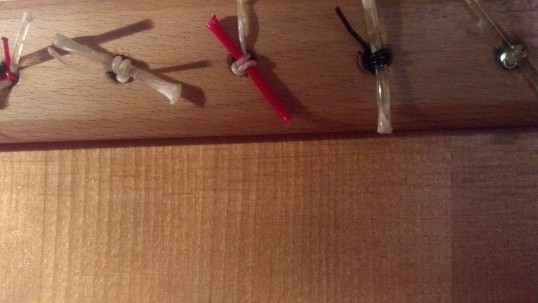So, you see some small cracks or splits running along the center strip on your pedal harp, and you’re wondering if this is a sign of scary expensive repairs to come. Fortunately, splits like the one shown in this photo are rarely a cause for concern. As ominous as they look, they are cosmetic, not structural.
The wood grain on this harp’s soundboard appears to run parallel to the center strip, but the wood you see is only a very thin veneer. The grain of the underlying soundboard actually runs perpendicular to the center strip. While the veneer is splitting, there is no way this split will transfer into the soundboard, since the grain direction is different.
If you have a pedal harp, take a flashlight and look at the underside of the soundboard inside the body. You’ll see that the grain of the board is horizontal back there, not running the length of the soundboard the way the top veneer does. In essence, the split you can see on the top is only “skin deep,” and won’t go past the surface layer of wood.
Why do these splits happen? Under string tension, the soundboard is naturally pulled upward. As harps age, they develop a degree of bowing or “bellying” in the soundboard. This is actually an important part of the harp’s sound. A bowed soundboard is more resonant than a flat one. This is one reason sound improves with age.
While the soundboard itself is built to withstand the stress of constant string tension, at least for several decades if not more, the veneer is literally paper thin. Moreover, wood is weakest along grain lines. The tension on the board is highest right in the center where the strings are pulling. Where the underlying soundboard can flex under tension, the surface veneer can’t always follow suit. This can results in splits like the ones shown above.
Can these be repaired? First of all, the word “repair” is probably too strong of a word. Nothing is really broken. Okay, you might say, can they be touched up? While I haven’t asked this question of a touch-up expert, I suspect any touc-up work would be temporary. This section of the instrument will continue to bow up over time, and finishes, like wood grain, don’t necessarily flex under tension.
When is a crack in the soundboard something to worry about? If you notice a crack running parallel to the center strip, but about one half inch to one inch away from it, then you have cause for concern. Underneath the board, there is another center strip, much thicker and wider than the one on the surface. A split or crack along the edge of the larger bottom center strip can be an indication that the soundboard is on its way to coming apart. If you do see something like this, shine a flashlight at it. If you can see light on the other side of the soundboard, it’s time to start thinking about replacing the board, or the harp, depending on its monetary and sentimental value.




0 Comments